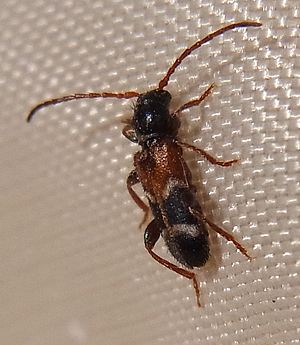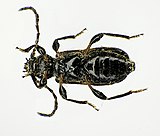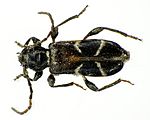Little Schönbock
| Little Schönbock | ||||||||||||
|---|---|---|---|---|---|---|---|---|---|---|---|---|

Little Schönbock |
||||||||||||
| Systematics | ||||||||||||
|
||||||||||||
| Scientific name | ||||||||||||
| Poecilium alni | ||||||||||||
| ( Linnaeus , 1767) |
The Small Beautiful Bock ( Poecilium alni ) is a beetle from the family of longhorn beetles . It is often called Phymatodes alni out of date . The colorfully drawn animal is four to seven millimeters in size.
The species is in the Red Lists of countries Brandenburg and Schleswig-Holstein as endangered , in Saxony and Thuringia as endangered highly classified. In Mecklenburg-Western Pomerania it is considered lost . In Saxony-Anhalt , it is on the warning list as potentially endangered .
Comments on the name and the system
The first description of the species was in 1767 by Linnaeus under the name Leptura alni . The species name "alni" ( Latin for Alnus, occurring alder ) names one of the host plants, but the species is by no means restricted to this tree. The generic name "Poecilium" (from ancient Greek ποικίλος poikílos, colorful) refers to the three-colored wings. This also explains the name Schönbock. Traditionally, Poecilium is a subgenus of Phymatodes . In Europe the genus Poecilium is represented with seven species, worldwide with 17 species.
Description of the beetle
The mouthparts point forward. The jaw probes are four-part, the lip probes are three-part. The eleven-jointed antennae are about body length in the male, while in the female they protrude above the middle of the wing cover. They are red-brown, getting darker towards the tip and not thickened. The second feeler member is relatively long, not ring-shaped. The third and fourth antennae are not very short. The fifth antenna segment is shorter than the third and fourth combined. The individual facets of the eye are very small. They embrace the base of the antennae in a kidney shape and are closer together on the apex than the antennae bases.
The pronotum is flat and rounded, like all disc bucks. It is colored black and its sides are rounded.
| Pictures of the little Schönbock | |

|

|
| Fig. 1: Light form | Fig. 3: Bottom |

|

|
| Fig. 4: side view | |

|
|
| Fig. 2: Dark form | Fig. 5: Front view |
The elytra are very finely dotted and flat. A tuft of hair sits behind the label on the suture on the wing covers (Fig. 4). In the first third the elytra are red-brown, behind dark. In southern Europe one often finds forms in which the entire elytra and the antennae are dark (Fig. 2). Usually the elytra are roughly divided into three by two white transverse bands. The transverse ties can also be dissolved in spots or widened and designed to run into one another. Usually both are curved, the front one being stronger. The rear runs diagonally, outside to the rear.
The front hips are close together (Fig. 3) and not separated by the fore-thoracic process. Your joint cavities are open at the back. The legs are short. The legs are stalked at the base, distally strongly thickened to form a club. The tarsi are apparently four-limbed (pseudotetrameric), since the fourth limb is hardly recognizable in the section of the lobed third tarsi. The first link of the hind tarsi is not significantly longer than the second and third link combined. The claws are imperforate.
biology
The species occurs in deciduous forests and on damp forest edges.
The larva is polyphagous and lives under the bark of one to two centimeter thick branches of various deciduous trees ( oak , ash , maple , alder , hazelnut , almond , oak mistletoe ).
The adults appear in spring (April) and can be found until June. You can find them flying in the midday sun. The species is often gregarious and abundant, but does not occur regularly. It is classified in the guild of fresh wood colonists, but you can find it on freshly cut as well as dried up twigs and branches, on diseased wood and on wooden fathers. Exceptionally, the beetles can also be found on flowers.
distribution
The distribution ranges from southern Europe to southern northern Europe, to the east to the Crimea and the Caucasus . In Central Europe the species is widespread, but very unstable. Occasionally it is frequent in one place for several years in a row, then disappears again for years. It is absent in higher mountain areas.
literature
- Heinz joy, Karl Wilhelm Harde, Gustav Adolf Lohse (ed.): The beetles of Central Europe . tape 9 . Cerambycidae Chrysomelidae . Spektrum Akademischer Verlag, Munich 1999, ISBN 3-8274-0683-8 (first edition: Goecke & Evers, Krefeld 1966).
- Adolf Horion: Faunistics of the Central European Beetles, Bd. XII . Überlingen-Bodensee 1974
- Klaus Koch : The Beetles of Central Europe . Ed .: Heinz Freude . tape 3 : ecology . Goecke & Evers, Krefeld 1992, ISBN 3-87263-042-3 .
Individual evidence
- ^ A b Systematics, synonyms and distribution of Poecilium alni according to Fauna Europaea
- ↑ Red lists at BioNetworkX
- ↑ C. Linnaeus: 1767: Systema naturæ, Tom. I. Pars II. Editio duodecima reformata first description page 639, no.19
- ↑ Sigmund Schenkling: Explanation of the scientific beetle names (species)
- ↑ Sigmund Schenkling: Explanation of the scientific beetle names (genus)
- ↑ Poecilium in Fauna Europaea. Retrieved February 26, 2013
- ↑ Poecilium at BioLib
- ^ Schmidl J & Bussler H 2004: Ecological guilds xylobionter beetles Germanys.-Nature protection and landscape planning 36 (7); Stuttgart as XLS (No. 1204) ( Memento of the original from December 27, 2015 in the Internet Archive ) Info: The archive link was inserted automatically and has not yet been checked. Please check the original and archive link according to the instructions and then remove this notice.